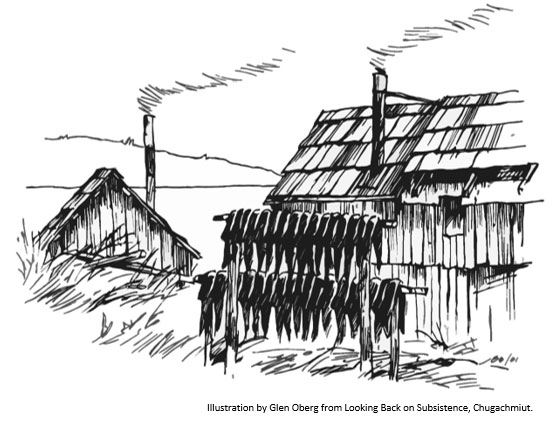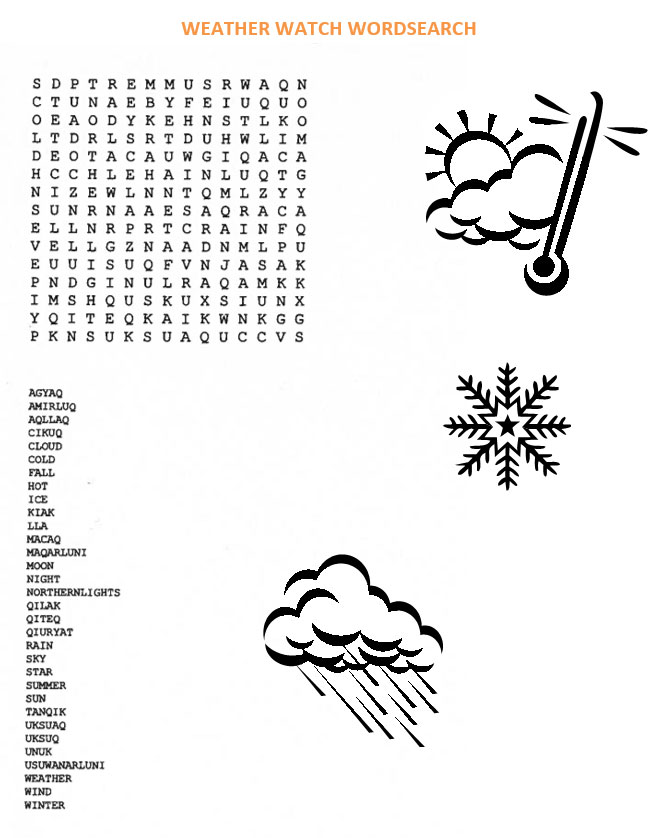Unit 4: Weather, Wind and Air
Cause and effect: Everything is related in the natural world, locally and globally.
Lesson Plan 1 “Weather Watch”

Summary: Students will investigate the weather systems that affect the Chugach region. What activities are affected by the weather in the communities? Students will also examine some of the ways that the Chugach tribes predict the weather and who the weathermen are. Students will also investigate the activities related to drying and smoking fish and game.
Grade Level:
K-4 / 5-8 / 9-12
Time required:
Five class periods of 45-60 minutes
Materials needed:
• Science journals
• Butcher paper
• Drawing paper, crayons, markers or art material
• Cloud identification cards
• Camera
Learning objectives:
• Students will observe the weather.
• Students will identify clouds.
• Students will understand how seasons occur.
• Students will report how weather and seasons are important in Alutiiq culture.
• Students will examine weather effects on local plants and animals.
Vocabulary introduced:
Weather, climate, low and high pressure, temperature, atmosphere, volume, expansion, barometric pressure, evaporation, condensation
National Science Educations Standards:
Earth and Space Science
Content Standard D: As a result of their activities in grades K-4, all students should develop an understanding of the following:
• Properties of earth materials
• Objects in the sky
• Changes in earth and sky
Content Standard D: As a result of their activities in grades 5-8, all students should develop an understanding of the following:
• Structure of the earth system
• Earth’s history
• Earth in the solar system
Content Standard D: As a result of their activities in grades 9-12, all students should develop an understanding of the following:
• Energy in the earth system
• Geochemical cycles
• Origin and evolution of the earth system
• Origin and evolution of the universe
Alaska State Standards:
Concepts of Earth Science
A student should understand and be able to apply the concepts, processes, theories, models, evidence, and systems of earth and space sciences.
A student who meets the content standard should be able to develop the following:
• An understanding of Earth’s geochemical cycles;
• An understanding of the origins, ongoing processes, and forces that shape the structure, composition, and physical history of the Earth;
• An understanding of the cyclical changes controlled by energy from the sun and by Earth’s position and motion in our solar system; and
• An understanding of the theories regarding the origin and evolution of the universe.
Background Information:
Local Story
|
THE BROWN SNIPE AND THE WEATHER WHICH CHANGED MOST OPPORTUNELY She sang: Next morning the sun came out, and the sky was blue. She felt happy. She turned the eggs on their sides and lay there sunning herself. She was sitting on the eggs, and a little snipe hatched before it started to storm again. So she did not care about the storm anymore.” |
Elders Observations
“Yeah, never seem to clear up, and stay clear. You know the weather isn't like it used to be years ago when she cleared up…you never had any power you know, all hand rowed and stuff…skiff, and used to go all around, and all around the place here…you know…around Prince William Sound. When the weather clear up, you have nice weather for a week, before she start get bad again. We always know when to come back. We sleep out, and you can't depend on the weather from day to day no more like that. Maybe sunshine is there, next morning it's raining and blowing.” (John Klashnikoff 1979: Side A, Tape Counter Number 025, BIA).
“Those people, they live accordingly. They seem to know what they were doing all the time. They can pick weather…you know…go out in bidarkies. They'd set out in the evening, day like this if it was cloudy, and go out and set for probably an hour, watch those clouds, you know? Just continually watching those clouds, and they have two layers of clouds, that they can tell which way the top layer's goin' and which way the bottom layer clouds are going, and then they watch 'em until they find when and where's the wea…” [tape recording ends] (John Klashnikoff 1979: Side A, Tape Counter Number 473, BIA).
“Yeah, he'd be the leader, sometime he wouldn't be the chief, but you'd be the leader of your party or a big party, see? A chief would be the leader of the village. The leader, like for instance Tatitlek, or Nuchek, or whatever it is, he'd be a leader of the whole…all the people. But when we're out, usually when they go hunting, like sea otter or something then…they went in say sometimes ten bidarkies…five bidarkies go out, see? Well, you have to pick a leader right away, see? And then they get in the smokehouse, and he says, "Well, now we'll have to pick the leader for this outfit, say ten bidarkies," and that's who you follow, and then pret' near everybody knows who is gonna be the leader by…just you live in the village long time, and you can tell the difference between people, and you got your leader picked pret' near all the time. So that's who you appoint for a leader, and you follow him. He's also the weather man. He's taking care of that whole fleet, see? When they come ashore, make camp and stay there. When they go out, and stay out in the ocean for a day or two, or two…three days, whatever he says it's not gonna blow. You follow him.
Ketz: So this is really a special guy, who knows…
Klashnikoff: A really special guy.
Ketz: …the weather too.
Klashnikoff: Yeah, he knows the weather. He's gotta know everything, see? Gotta know the weather, know the sea, and…yeah, they're out where don't see no land at all, and then they just stay and float out there. They tied their bidarkis together, see? Then they float out there the next day.” (John Klashnikoff 1979: Side B, Tape Counter Number 001, BIA).
|
“It has been weird weather here. We used to get a north wind a lot. It used to get rough out here.” (Carroll Kompkoff, Cordova. From ANSC Western Region Report on Changes, 2002) “I remember we used to get a north wind in Chenega.” (Mary Kompkoff, Chenega Bay. From ANSC Western Region Report on Changes, 2002) “My Uncle Wally used to predict summer. First day of spring, he’d say, “Well it looks like we’re going to have pretty rainy weather this year.” He’s the one who taught me how to navigate. His navigation said don’t go toward the swells, go toward the shine. He was right. He used to predict the weather and now what I think he’s saying is something’s wrong with the ozone and the line-up because our elders are confused now. If Uncle Willy were still alive, I suspect he’d say the same thing your people are saying. We go back to El Nino. We’re not scientists but we know that our people used to be able to predict these things and can’t now.” (Lydia Robart, Port Graham. From ANSC Western Region Report on Changes, 2002) “The climate seems to be warming and with climate warming, water temperatures change.” (Nick Tanape, Elder, Nanwalek. From Imam Cimiuca, 2010) |
Resources: Alutiiq Words
Weather Related Terms
| Aurora Borealis/Northern Lights | qiuryat |
| Cloud | amirluq |
| Cloudy, be cloudy | taluluku |
| Cold (weather is) | usuwanarluni |
| Clear (weather is clear) | ikirlluku |
| Day | erneq |
| Fall | uksuaq |
| Fog (from ocean) | umek |
| Fog (from lakes, mountains) | taituk |
| It's foggy | umgaa |
| Hot | maqarluni |
| Ice | cikuq |
| Lightning | nani’artuq |
| Melt | uruglluni |
| Morning | unuaq |
| Moon | tanqik |
| Night | unuk |
| Rain | qiteq |
| It is raining | qiterluni |
| Rainbow | puusim qilau’utii |
| Sky | qilak |
| Snow (falling) | qaniq |
| Snow (on the ground) | aniuq |
| It is snowing | qanirluni |
| Spring | iciwaq |
| Star | agyaq |
| Summer | kiak |
| Sun | macaq |
| Sun is shining | macarluni |
| Sunrise ("sun comes up") | macaq puguq |
| Sunset ("sun goes down") | macaq taluq, macaq taluga |
| Weather | lla |
| The weather is good right now | nutaan lla asirtuq |
| Wind | aqllaq |
| The wind blows | aqllalluni |
| Where is the wind blowing? | Nakerta? |
| East wind | ungalaq |
| Northeast wind | waasarnaq |
| South wind | kanakeq |
| Southwest wind | ikakeq |
| West wind | kanaknak |
| Winter | uksuq |
(From Nanwalegmiut Paluwigmiut-llu Nupugnerit – Conversational Alutiiq Dictionary, Kenai Peninsula Alutiiq by Jeff Leer, 1978)
Resources: Literature, audio, video, other curriculum
Literature
• Adler, David A. World of Weather (The Question and Answer Book). 1983. Troll Communications.
• Cosgrove, Brian. Weather (DK Eyewitness Books). 2007. DK Publishing, Inc.
• Dick, Alan. Village Science, Chapter one; Cutting and Drying Fish. 1997. Alaska Native Knowledge Network.
• Foster, Russell G. Seasons of Life: the Biological Rhythms That Enable Living Things to Thrive and Survive. 2009. Yale University Press.
• Green, Jen. Weather and Seasons. 2008. The Rosen Publishing Group, Inc. New York.
• June & Preszler. Where Does Lightning Come From? A Book about Weather. 2007. Capstone Press.
• Lethcoe, Jim. The Weather and Climate of Prince William Sound. 2003.
• Time Life Books. Weather and Climate (Understanding Science and Nature). 1993. Time Life Education.
Other curriculum
• Chugachmiut. Culture, History and Heritage of the Chugachmiut, Level 2, Grades 1-3, Living in Place, lesson 9: Cycles of Winds. 2007.
• Alaska Sea Grant. Alaska Seas and Rivers Curriculum/Weather and Circulation Systems. Available online: http://seagrant.uaf.edu/marine-ed/curriculum/grade-7/investigation-2.html?task=view
• Alaska Department of Fish and Game, Division of Wildlife Conservation. Alaska Wildlife Curriculum, Alaska’s Ecology: Science Cards “Wind and Air Temperature”, p. 63 and “Air in Ecosystem #1 and #2” p. 73 – 77. 2005.
SmartBoard
• Weather. This presentation includes use of weather words, the water cycle, using a thermometer, and descriptive writing. (1-3). http://exchange.smarttech.com/details.html?id=eca613c6-ca27-4d8e-a72f-e1c45d868cb2
• Weather. Learn about the weather. Observe and describe different types of weather and changes in weather. Fun activities for the students (1-3). http://exchange.smarttech.com/details.html?id=03bc4a47-e5f1-42ba-bc51-d86b6068faa8
• Weather & Climate. Enhance your student's learning experience with our 20 screen page lesson plan on Weather & Climate. Get the best out of your SMARTBoard and create an opportunity for your students to get more involved in your lessons. The ready-made lesson offers interactive reading passages, before and after you read interactive activities, a printable reading passage, interactive water cycle activity, and SMART Response quiz along with supporting audio and video. This comprehensive lesson was created by CCP Interactive. (7-9). http://exchange.smarttech.com/details.html?id=297702f0-8e77-49ac-a0e9-0d373232a932
Procedure:
Engagement
• Have students share stories about the worst weather they were ever in, describing what made it so bad.
• Take students on a walk to observe the sky and to pay attention to everything that contributes to weather.
• Discuss the walk and observations made.
• Have student write down their prediction of what the weather is going to be like for the next day, giving reasons for the prediction.
Exploration
• Find out student’s prior knowledge on the topic by creating a KWL Chart (What we Know, What we Would like to learn, and What we have Learned). Refer to the KWL chart daily for updates.
• What is weather? Explain that it is what the air is like outside, moist, hot dry, rainy, etc.
• Ask the students how you know there is air? Discuss the question and then have the students prove there is air.
Explanation
• Teach the students about air; we cannot see it, yet it is there; it fills all common spaces and tends to expand when warm and contract when cool. Air can move with some effort, when it is compressed, its temperature rises; when it is allowed to expand its temperature falls. The atmosphere puts the pressure on all things it surrounds including air. Because cold air cannot contain as much water vapor as warm air, condensation may occur when moist air cools. A cloud is visible evidence of a process; it is continually changing and is not a permanent object.
• Go over the vocabulary words and definitions with the students. Discuss the meaning of the words. Introduce the indigenous words.
• Teach the students how to use a cloud identification card, and then take them outside to practice identifying clouds. Have ten minutes of quiet observation as they record observations in their science journals.
• Ask the students to tell you what the differences are between the four seasons in the Chugach Region. Use the following questions:
- In what season is it darkest, and in what season is it lightest?
- What season allows you to play outside late into the evening?
- What happens to plants during each of the seasons? What about animals?
- In which season do you see the most flowers?
- Does everyone in the world experience the seasons the same way? Why or why not?
• Assign each student one of the seasons, then have them get into their season groups. Give each group blank paper and crayons to draw pictures that are associated with their assigned season.
• Have the student make a list of the foods and activities that they associate with their assigned season. Have a discussion on why that particular food item goes into their season. Have them explain in a three-paragraph essay what the weather is like currently using the example of fishing for salmon; that the summer is when the salmon are on their way back to the spawning grounds so we are able to catch them. If the summer season was dry and warmer we are able to cut the fish and dry it for eating later in the year. If the summer was wet (rainy) and cooler then we would have to use heat in the smoke house to dry the fish or else the fish would spoil.
Elaboration
• Direct students to interview community members on weather prediction methods that the Alutiiq used and write up the interview.
• Have students write stories about their families’ lives and the activities they participate in based on the seasons (fishing, berry picking, etc.).
Evaluation
• Student journals
• Student participation
• Student drawings of the seasons
• Students correctly use the vocabulary words.
• Completed interview and essay
Follow Up Activities:
• Fill out the seasonal species harvest table with community elders and the students. Find out the local, common and scientific names of the bird and insect species.
• Meet with an elder to learn about weather predicting. What are the weather signs in your area? What do the different kinds of clouds mean in terms of coming weather? What direction do your storms come from?
• How has fish/salmon traditionally been dried in your region? How is it dried now? What kinds of buildings and wood have been used for this? Meet and discuss this with an elder.
• Write a weather diary for one week. Compare with other students’ diaries. Take pictures of the different clouds and skies, and compare with other students.
• Play the “Weather watch” word search (you can find the activity sheet in the Document Library and print them out, or use SmartBoard).

